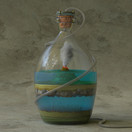Winners
The Computer Graphics Forum 2020 Cover Image has been selected by the CGF editorial board. We thanks all people who submitted this year, and hope that they will participate to the next year contest.
Winner of the Computer Graphics Forum 2020 Cover Image Contest

Károly Zsolnai-Fehér (1), Peter Wonka (2) and Michael Wimmer (1)
(1) TU Wien
(2) KAUST
This image shows the "Paradigm" scene from our paper named "Photorealistic Material Editing Through Direct Image Manipulation" paper. In this work, we presented a technique that aims to empower novice and intermediate-level users to synthesize high-quality photorealistic materials by only requiring basic image processing knowledge. Our method takes a marked up, non-physical image as an input and finds the closest matching photorealistic material that mimics this input. The entire process takes less than 30 seconds per material, and to demonstrate its usefulness, we have used it to populate this beautiful scene with materials.
Below, we explain three examples shown in this image (noting that the scene contains more synthesized materials). First, the gold material was "transmuted" from silver by editing the color balance of the image, second, the dirt material below was made by using image inpainting, while third, the vividness of the grass material was done through a simple contrast enhancement operation.
The geometry of the scene was created by Reynante Martinez.
For more information, the entirety of the paper and the described technique are available here: https://users.cg.tuwien.ac.at/zsolnai/gfx/photorealistic-material-editing/
Second place:

Dennis Bukenberger and Hendrik Lensch
Uni Tübingen
Our contribution is a beauty-shot, created from the results of a meshing pipeline to reconstruct surface and volume meshes. The chosen object visualizes the transition from the input point cloud in form of a child to the final mesh personified by the mother. The procedure relies on an orientation field and a neighborhood graph, both are utilized here to emphasize the invisible connection between a mother and her child. The rendering was created using Blender and can be reproduced in any resolution.
Third place:

Joshuah Wolper, Yu Fang, Minchen Li, Jiecong Lu, Ming Gao and Chenfanfu Jiang
University of Pennsylvania
We simulate tearing a slice of fresh bread with more than 11 million Phase Field Fracture-Material Point Method particles (PFF-MPM). This coupled momentum/damage solver produces convincing continuum fractures through tracking a field of phase (damage) variables and evolving them over time. On the left we color the bread with a color ramp based on the damage (red being damaged material and blue being undamaged material); on the right we use volume rendering to realistically visualize the bread dynamics.
Note: we can re-render with different aspect ratio or noise level if needed!
